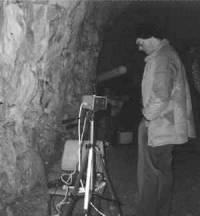Using People on Vigils

Vigil versus witnesses
It is tempting to regard casual witness reports of a haunted building as anecdotal compared to the 'solid' data from vigils. Consider the problems with casual witnesses:
- they are unprepared (no equipment!)
- they are unlikely to be trained observers
- they may be shocked by the experience, affecting their memory
- they may take time to report the experience, dimming the memory
- they may discuss the experience with people who could influence them
By contrast, observers at vigils are prepared, equipped, able to report immediately and some are trained. On the face of it, observer reports from vigils are much more credible than those of casual witnesses to spontaneous events.
However, observers on vigils suffer from problems too. For instance:
- they know the place is haunted and so may be subject to suggestion
- they may have strong beliefs in paranormal activity
- if vigils are held in the dark, partial sensory deprivation may lead to hallucinations
- they may be in a heightened state of awareness
The last point refers to the fact that people on vigils tend to notice every small thing, like a creak or reflection. Most of these occurrences will have mundane explanations.
Consider the following hypothetical incident on a vigil. Out of a group of five people, three report a groan, one a whisper and the fifth, nothing. What is one to make of such a report? Do you take a vote? Science doesn't work like that. The observation needs to be unambiguous to be taken seriously as evidence.
To improve the evidential value, you could ask everyone where they heard the sound coming from. If all those who heard it agree, it would reinforce the report. (You should note, however, that sound can only be located at certain frequencies so everyone may disagree even about an objective sound!) You could ask the person who heard nothing what their normal hearing is like (or, better still, test it in comparison to the other observers!).
You can help reduce observer problems by (a) holding vigils with lights on, (b) stationing people alternately in 'haunted' areas and non-haunted areas (without their prior knowledge).
Everyone considering holding a vigil should also consider what people experience in this situation. A vigil is a group activity and psychological dynamics have to be taken into account.
When people go on their first vigil at a venue, you also need to consider the new house effect!
Trigger objects
You might think that trigger objects should be listed under equipment for vigils. However, the concept of the 'trigger object' is a human one.
The object itself is not an instrument, it's usually just an inanimate thing. The form that it takes, however, is seen by users as important.
Many years ago (long before trigger objects became famous on TV!), ASSAP did an experiment at a vigil at Charlton House. A series of small objects were left in strict pattern of regularly spaced rows on the floor of a room. The room was then sealed until the end of the vigil. Then it was checked to see if the objects had been disturbed. The reason for this experiment was that objects had frequently been found to be moved when the room was empty. So, essentially, it was a test to see if any objects would be moved by whatever agency might be involved.
Trigger objects are similar in that they are designed to look for object movement. However, the objects chosen (such as crucifixes) often have clear symbolic significance. There is an obvious assumption here that it is a 'spirit' or intelligent entity that is supposed to move the object. Otherwise, there would be no point to using an object with symbolic significance.
If you want to use trigger objects to test for object movement where it has been reported that's fine. But you should use neutral objects or, better, things that have been reported to move before. Also, you should train at least two video cameras on the object (looking from different angles and distances) to see what's going on properly.
The use of symbolic objects says more about your assumptions than the actual agency responsible. There are mundane reasons why objects ,ight move. Small objects might, for instance, be being moved by pets or rodents. If a pet moves a crucifix, it doesn't indicate that a 'spirit' is involved.
Inconsistency = paranormal?
Everyone is different. We all experience the world in a slightly different way. We all see colours slightly differently (people disagree about the most 'natural' colour balance on a TV). MRI scans show that people react differently to the same sound. Compared with instruments, humans are inconsistent.
Interestingly, if a machine records something that a witness present at the time doesn't, some people assume it is paranormal. Think of EVP and orbs. Similarly, if people hear a sound, for instance, on a vigil but a tape recorder present at the time doesn't, some people assume that is paranormal too! It seems that some people see inconsistency between machines and men as a sign of the paranormal.
In fact, many of the inconsistencies between machines and men are explained by different specifications. You shouldn't assume something is paranormal without a lot more evidence. In particular, you need to understand your instruments and their limitations and also know a bit about the human mind works.